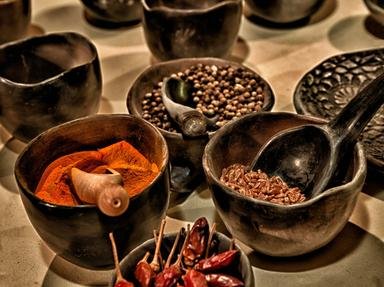Quiz Answer Key and Fun Facts
1. Harissa paste is a spice blend made with red chili peppers, garlic, coriander, caraway, cumin and oil that originated in what region?
2. Which of the following civilisations is believed to be the first to experiment with turning mustard seed into a condiment?
3. Five Spice is a common blend used in Chinese cookery with heat from at least one pepper. Which of these is NOT a common ingredient in this condiment?
4. Its botanical name is Carum persicum Boiss and it is often confused with the totally unrelated nigella. You won't have to think too hard to determine what is the more common name of the spice kala jira?
5. What compound gives pepper (Piper nigrum) its pungency?
6. Commonly used in gumbo, and far from rank, which spicy powder is produced from dried sassafras leaves?
7. The spicy root vegetable horseradish is a member of which of the following families?
8. Chipotles are often added to Mexican dishes to add heat. What exactly are they?
9. Curry is a tamil word meaning "Sauce or relish for rice" which can be traced back almost 4000 years. True or False: The addition of chilies to curry blends is known only to have occurred in the most recent 500 years.
10. The measurement of the pungency of spicy foods can be quantified. What is the name of the scale used?
Source: Author
1nn1
This quiz was reviewed by FunTrivia editor
WesleyCrusher before going online.
Any errors found in FunTrivia content are routinely corrected through our feedback system.
